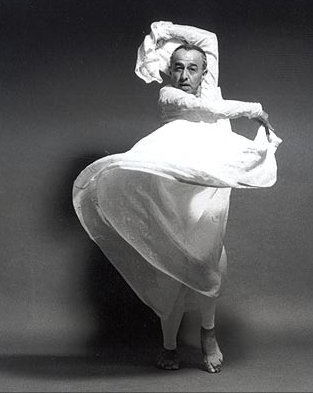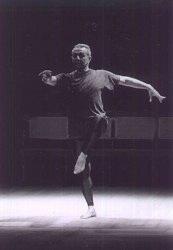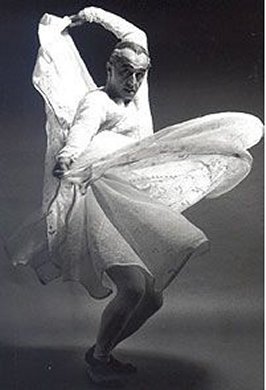
|
 |

|
 |
ASTAD DEBOO - Lalitha Venkat, Chennai e-mail: lalvenkat@yahoo.com Nov 20, 2001  Copyright: Farrokh Chothia Born in 1947 in Navsari, Gujarat, Astad Deboo initially received training in Kathak under Guru Prahlad Das in Calcutta and in Kathakali under Guru E K Panicker. Later, he attended the London School of Contemporary Dance learning Martha Graham's modern dance technique and learnt Jose Limon's technique in New York. He also trained with Pina Bausch in the Wuppertal Dance Company, Germany and with Alison Chase of the Pilobolus Dance Company. Along with these and other experiences with dance companies in Japan and Indonesia, he has created a dance theatre style of his own which successfully assimilates Indian and western techniques. He has experimented with a variety of forms, themes, concepts and performance spaces and has collaborated with other dancers, composers and designers to create innovative works of aesthetic value. Recipient of the Sangeet Natak Academi Award for Creative Dance in 1995, Astad Deboo pioneered modern dance in India. He works regularly with the Action Players, a group of deaf actors in Calcutta. He has performed at the Great Wall of China, with Pink Floyd in London and at the 50th anniversary of the American Dance Festival. Deboo was commissioned by Pierre Cardin to choreograph a dance for Maia Plissetskaia-prima ballerina of the Bolshoi Ballet and has given command performances for the royal families of Japan and Thailand. He was the first contemporary dancer to perform at the Elephanta and Khajuraho festivals. He has conducted workshops at the London School of Contemporary Dance and the China Academy of Arts, Beijing. Astad's most recent performances have been in the Kala Ghoda Festival in February, Festival of Lighting in dance for the Festival of Germany in Delhi on March 11, 2000. He had been commissioned by the Hong Kong curator of Theatre Danny Young for the Festival Journey 2000 in Hong Kong. He worked with Chinese actor Cedric Chan. Astad's work got selected for the Festival of Vision in Berlin in 2000. He has performed in the Festival of Berlin in Hong Kong with musicians Amelia Cuni and Werner Durrand in the Festival of Macau. He works with deaf theatre companies in Mexico and Hong Kong. Always on the move, Astad personally coordinates his programs, which stretch across 5 continents. What motivates you to work with the hearing impaired in India and abroad? I've been working with the deaf. It's now politically correct to call them 'deaf'; before, it was 'hearing impaired'. I've been involved with them for the past 14 years. It started off with a group in Kolkata called The Action Players with whom I'm still associated and subsequently, I've also been very much associated with the Gallaudet University in Washington DC which is the first liberal arts university for the deaf. From there, my most recent involvement has been with the Mexican Deaf Theatre Company and with one of the Deaf Theatre Companies in Hong Kong. Generally all these projects which I do result eventually in a production. So they normally start off with a workshop situation and then a work is developed. Teaching them a method, which I've evolved for myself, is very different from what I've seen my other colleagues when they teach; the wooden floor being a very important aspect of a necessity because of the fact that they pick up the vibrations and my work is choreographed to the music. So the way I break it up is all on counts, so basically the foundation is on the counts of 8 and then it goes on to 16 or 4s depending on how the work is being created.  Do you feel your choreography/work is better accepted abroad than here in India? Well, definitely people overseas come with, what shall I say, with no preconceived notions, they come with an open mind. Certain places I go to perform, I return to those places quite regularly, so there also I've created a sort of a small audience who are familiar with my work. Yes, basically abroad, there's no sort of preconception and then again there is no pettiness, which unfortunately is very prevalent not only among the dance fraternity, but even in general in the performing arts. I talk more of my experiences in the city I live in, Mumbai where I find it extremely frustrating. In fact, I really work there in isolation because of the fact that being the sort of hub of MTV and Bollywood…. OK, Bollywood is fine, nothing particular against it, just in general the people there. I do find there is a certain amount of openness in the Hindi and Marathi theatre, but not so in the English theatre. They think they're the cat's whiskers. I've given a long-winded answer! Coming back to your question, my work is through the years of having sweated my blood and still I continue to do that. People are very skeptical, they come with an agenda of their own and I've also been with certain dancers whose names I've not mentioned. When they go to see another dancer, they come with the idea that automatically they're not going to like that person's work. And they come basically to criticize. I'm sure there is insecurity among dancers, not only here, there's insecurity everywhere. I've been in close quarters with dancers in Mexico, in the US, in France. The pie is small; everybody wants to have a piece of it. But still, I wish people were a little more open, a little more giving and taking. You choreograph your movements in slow motion. Sometimes, it's almost trancelike... do you sort of lose yourself? How well does this type of choreography go down with the audience? Right now, my choreographic work for my own self is very minimalistic, compared to sometimes when I choreograph for other people where the movements are much more fast paced, like when you saw 'Celebrations' last night, certain parts when the martial arts people were performing. Though people sometimes feel that I go into a trance, I'm still very much aware. I do work with the rasas; though the work sometimes is abstract, the work has a lot of feeling to it. I may extend the hand, but when I extend the hand, whether I'm doing the Bhakti or Sringara rasa, which is in my mind for that particular choreography, that's when it sometimes feels as if I'm going into a trance. In the earlier days, in fact, last night when I saw in Chennai, certain gurus come backstage, I know that a decade ago, they would never have come backstage and not wanting to be seen...but times have changed, it's nice and I do not hold any grudges, OK, I understand. I also feel that now slowly the old school is opening up, at least accepting. Whether you like the work or not is a personal matter and it's understandable that each creator's work need not necessarily be very good. But it can be very good too. It's not that... What inspired you to collaborate with the Manipuri martial artists in 'Celebrations'? As you know, for a good two decades, I've worked as a solo performer. I still do solo works but there came a time when I felt that in the scenario of the Indian performing scene, people were now a little open, maybe still not accepting, but at least they are willing; even the collaborators. I've worked with Dadi Padamji in Puppets, the Gundecha brothers who have been collaborating with me since 1990. We first started work in 1989 when I asked them to collaborate with me for the Khajuraho Dance Festival in 1990. So I always look at a lot of work of all performing arts. I'd seen the thang ta art form many years ago, over 20 years ago, and there came an opportunity. These works, in order to be developed, need money. I happened to get a commission for the Onida Television Awards and they wanted something different. I had this idea, so I went to Imphal and met Guru Devabrata Singh, who is the guru of the Hula Group, the group I've been working with and I asked for his permission. And what attracted me more to the Hula technique is their form. I can relate it to my form the way I do it and I also saw that they were willing to leave their swords and sticks. I've used their technique. While collaborating, I've always bounced my work off using the collaborators' technique and then sort of adding on mine, like when one is working overseas and it's a different kind of vocabulary. When I would work with an Indian classical dancer, I would try to use their base. When one is familiar with either the Bharatanatyam technique or the Kathak technique, or even the Manipuri or Odissi technique, I would use that as a bouncing off to work with the language they have and it's easy for them, and then I sort of add on mine. That's my approach. ..interweaving? Yes, that's right.  Copyright: Farrokh Chothia What are your guidelines to upcoming artistes to keep physically fit? (Laughs) I'm not a physical instructor!! Physical fitness is a precondition for rigorous activity. How do you maintain physical fitness? Speaking for myself, the way I try to keep myself fit, definitely there's the diet control. Also, just exercising the body. And again different people have different ability of stretching, and flexibility. If you can exercise, walk, swim, that would certainly help. Many are aware that you collaborated with the rock band Pink Floyd. How did that come about? This was way back in 1969, oh my...that was ages ago! It's been 32 years now. You know the work, which brought us together, was a fundraiser. It was organized by Winston Churchill's granddaughter Arabella Churchill and they were raising money for the lepers of India and Africa. They were on the programme and I was on the programme. I danced to one of their very first albums called 'Meddle'. I'd heard it; they'd seen my dance. So, they played it and we did sort of an improvisation since I knew the music they were playing. So, that's my collaboration and performance with Pink Floyd. It was done in Chelsea Town Hall, London. Your forthcoming projects... The immediate ones I have are, I'm working in England in Winchester at King Alfred's College with a music composer by the name of Francis Silkstone who's composing the music for the very well known myth Orpheus and Eurydice. This is an experimental work, which is being called 'Crying Orpheus' where Orpheus is on trial after he has lost Eurydice in the underworld. There's Amelia Cuni, an Italian singer, who for many many years has learnt in the Drupad school under the Malliks, she's quite a known performing figure now in Europe. So, she's also part of the collaboration. I'm working also with the students of King Alfred's College, which has a performing arts section. The other project, as I mentioned earlier is working with the deaf and the Action Players, which is a deaf theatre company based in Kolkata for 28 years. I'm going to be creating a new dance work for Deaf Way, which is an international festival for the deaf performing arts where about 60 countries are going to be participating. I'm going to create a work, which will be shown in America in early July. |